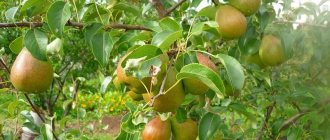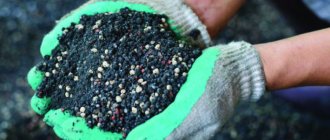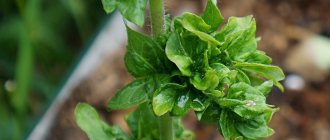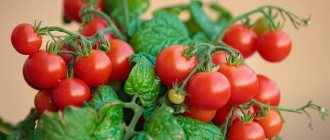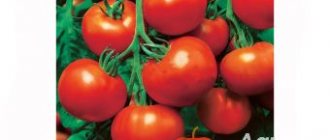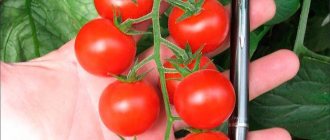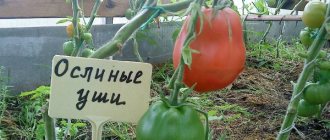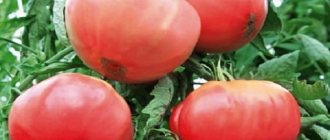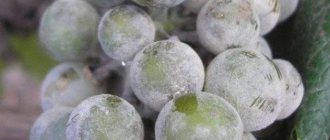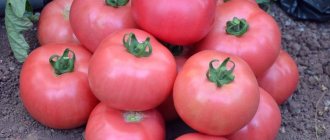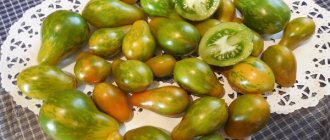Tomatoes contain useful minerals and vitamins. But among all varieties, the record holders for the amount of pectin are the raceme varieties, which are characterized by fruits that are standard in parameters, resistant to temperature changes and unfavorable climate conditions.
One of them is the Carpal Punch tomato.
Description of the variety
The f1 hybrid was obtained by Russian breeders. The rules for planting seedlings and further care depend on the climate of the region where the crop is grown. If the warm season is short, it is recommended to plant tomatoes under cover.
Distinctive features
Bush tomatoes ripen in 90-105 days. The plant belongs to the indeterminate type. The young shoot quickly gains growth; by the end of the first month after emergence, the height of the bush exceeds 1 m.
The foliage is average. One of the advantages of the variety is its high setability. The inflorescences are simple, the racemes also have no features. About 18 fruits are formed on each.
Reference! The height of the bush by the fruiting period reaches 1.6-1.8 m.
Fruit characteristics, yield
The fruits of the hybrid have a pronounced red color and ripen almost the same size. The weight of one is 120-140 g. Fruiting is extended, lasting for 2-4 weeks.
The crop is harvested using branches, which extends the shelf life of fresh tomatoes. Tomatoes do not change their taste and commercial characteristics for about a month.
Tasters highly appreciated the taste and value of the fruit. The composition contains an increased amount of vitamins. The harvest is used both fresh for preparing various dishes, and canned (twists, purees, paste, juice, etc.).
Pest and disease control
Like all crops, brush tomatoes are susceptible to various diseases and pests. One of the main and dangerous fungal diseases for tomatoes is late blight. Features of the plant damage are brown spots on the leaves. The disease is dangerous because it spreads very quickly and completely destroys the plant.
To avoid diseases such as cladosporiosis, fusarium wilt, and blossom end or root rot, you should choose first-generation hybrids for planting in a greenhouse. But regardless of the chosen variety of tomatoes, fertilizing and fertilizing are mandatory conditions. So, the basic rules that must be followed when growing truss tomatoes:
- abundant and frequent watering;
- regular ventilation of greenhouses;
- frequent loosening of the soil;
- timely feeding.
Growing the best grape tomatoes is not difficult in the climate of our country.
It is important to just follow simple recommendations. Today there are quite a few varieties of this crop
Each type has its own characteristics and strengths. Therefore, before planting, you should familiarize yourself with all the benefits of the plant, its features and tips for growing it. Tasty and beautiful tomatoes are the result of the work of a gardener who does everything right.
How to grow seedlings
The seedling method is considered the most productive way to grow Carpal tomatoes. There is no need to spend money on seedlings. You can grow high-quality seedlings yourself.
Seed preparation
Sowing of seeds is planned a couple of months before transferring the seedlings to open ground. Planting material is carefully sorted, small specimens with signs of damage are removed. The remaining seeds are soaked in potassium permanganate for disinfection.
You need to keep the gauze napkin with the preparation in the solution for 20-30 minutes. After this, the bag is rinsed with clean water, and the seeds are laid out to dry under natural conditions (without the use of heating devices).
Reference! To increase seed germination, it is recommended to treat with a growth stimulator.
Container and soil
For sowing, you can choose plastic containers, wooden boxes or peat pots. The height of the sides of the container should not exceed 15 cm. Fill the container with soil mixture purchased in a store or made with your own hands.
- When using ready-made soil, preference is given to a universal mixture or special soil for tomatoes.
- The homemade composition includes the following components: garden fertile soil, peat, humus, river sand. Bulk materials must be heated in the oven for disinfection before mixing.
How to grow tomatoes
In general, caring for the Carpal Impact variety is unpretentious. But you should not ignore the general rules of agricultural technology.
Landing
The beds for seedlings are prepared in advance. The soil is disinfected and fertilized with nutrient mixtures. The Carpal Impact variety responds well to mineral fertilizers and organic matter. The plant is tall and the bush will not be able to form normally on poor soils.
It is recommended to plant 2-3 roots per 1 m2. Experienced gardeners advise using the scheme: 70x40 cm.
Reference! Immediately after planting, the seedlings are generously irrigated with warm water. For the first 7-10 days, watering is carried out daily. This way the plant quickly adapts to new conditions.
Care
Tomato productivity largely depends on proper care. The plant needs sufficient water and nutrients, so irrigation and fertilization are carried out on a schedule.
Watering is done as the soil dries out. On hot days, the beds are irrigated every evening after sunset. The water should be warm and injected under the root.
Tomatoes require a lot of moisture, but stagnation of water in the soil is considered unacceptable. Mulching will help protect the plantation from drying out.
Nutrients are added at least three times:
- after planting seedlings (after 2 weeks) - minerals enriched with nitrogen, potassium, phosphorus, etc. are used;
- at the stage of ovary formation - solutions based on organic matter (mullein, bird droppings, rotted compost, etc.);
- during the flowering period, foliar feeding is carried out with a solution of boric acid.
For better absorption of nutrients by the root system, it is recommended to periodically loosen the soil. This opens up access to oxygen, prevents moisture stagnation and compaction. It is recommended to combine this activity with weeding. Weed-free beds minimize the development of fungal infections and the invasion of harmful insects.
Agricultural cultivation technology
The best yield indicator is obtained when using the seedling cultivation method. To form strong tomato sprouts, simple rules of agrotechnical measures must be observed.
Seeds are planted for seedlings 55-65 days before the expected date of planting in a permanent place. Seed material is placed in containers with prepared soil to a depth of 1 cm.
After watering with warm water, cover the container with film. To ensure easy seed pecking, maintain the air temperature at +21 °C. In the phase of formation of 2 true leaves, diving is carried out in separate containers.
The formation of healthy seedlings depends on the lighting regime. To extend daylight hours, fluorescent lamps are used. Before planting in the ground, seedlings are hardened off for 7-10 days.
The recommended planting density is 2-3 plants per 1 m². In a permanent place, the bushes are placed at a distance of 40 cm from each other, and a distance of 70 cm is left between the rows.
Plant care consists of following standard rules for tall tomatoes. Fresh bushes need to be planted in the ground to preserve the first flower stalks. It is recommended to apply nitrogen fertilizers in the form of an aqueous solution to the soil at the root.
To ensure the formation of ovaries, the bushes are treated with boric acid. To speed up flowering, the crop is fed with iodine. To do this, prepare an aqueous solution at the rate of 30 drops of iodine per 10 liters of water, which is used to treat the plants once a week.
Vegetable growers recommend replanting tomatoes in the afternoon if the weather is hot outside. On a cloudy day, you can plant at any time. It is better to fertilize in the late afternoon to protect the bushes from burns.
Throughout the entire period, you need to carefully monitor the development of tomatoes. If the plants have a frail appearance, it is necessary to fertilize them with organic fertilizers. With rapid growth, the amount of nitrogen components is reduced. Yellow foliage indicates excess phosphorus.
If there is a deficiency of potassium, the leaves may dry out. Ripe tomatoes should be picked with their stems on to speed up the ripening of other fruits.
An indeterminate bush requires tying to a support, timely watering, loosening the soil to create a moisture balance and air access to the root system.
Tomatoes contain useful minerals and vitamins. But among all varieties, the record holders for the amount of pectin are the raceme varieties, which are characterized by fruits that are standard in parameters, resistant to temperature changes and unfavorable climate conditions.
One of them is the Carpal Punch tomato.
The nuances of growing in open ground and in a greenhouse
The general rules of agricultural technology for tomatoes grown in a greenhouse are not much different from cultivation in open ground. However, there are nuances that are worth paying attention to.
- Despite the resistance of the Carpal Impact variety to late blight, in greenhouse conditions the risk of developing fungal infections increases. This is due to high humidity levels and insufficient air circulation. To prevent the problem, it is recommended to observe intervals when planting seedlings (2-3 plants per 1 m2), as well as regularly ventilate the greenhouse.
- A drip irrigation system is ideal for Carpal Impact. With a well-functioning program, moderate irrigation of the beds is ensured.
- The bush is molded exclusively into one stem. Side shoots are removed.
- In industrial cultivation, harvesting occurs when the color of the peel changes from green to brown. The fruits ripen already in boxes during the period of storage and transportation of tomatoes.
Gardeners' opinions
Good day! For gardeners and tomato lovers, I recommend the hybrid variety Carpal Impact. The plant is not capricious, the yield is high. Fruits can be collected in clusters or one at a time. The taste is excellent. I recommend.
Anna Schwartz, 54 years old
Good afternoon! I discovered the Carpal Stroke tomato last summer. The early variety loves feeding and greenhouse growing conditions. It is important to install supports and tie them up in time. The effort is justified by a good harvest and sweet berries. I recommend!
The tomato Carpal strike belongs to the first generation hybrids of the carpal type, cultivated by Russian breeders. Tomatoes are distinguished by their taste, smooth ripening of fruits, and versatility of use in cooking.
Harvesting and application
Harvesting begins at the end of July. If the crop is grown in greenhouse conditions, the fruits ripen 2-3 weeks earlier. Branches with tomatoes are carefully cut from the bush and stored in this form until the vegetables are sold or processed.
The use of the fruits of the variety in question is universal. Various salads and sauces are prepared from fresh tomatoes. The juicy pulp is ideal for juices. The average size of tomatoes allows you to prepare all kinds of twists for the winter. The durable skin can withstand heat treatment both when pouring boiling water and during sterilization.
Advantages and disadvantages of the variety
The Carpal Impact variety has been grown in Russia not so long ago. The growing popularity is explained by a number of advantages that tomatoes have.
- The variety can be grown in open ground conditions and all types of greenhouses.
- Possibility of cultivation on an industrial scale.
- Short ripening period. Technical ripeness occurs approximately 3 months after emergence.
- Unpretentious care. The bushes develop well both in sunny areas and in partial shade. Prolonged rains also do not create problems for crop vegetation.
- Stable yield. An average of 26-28 kg is removed from 1 m2.
- Strong immunity. This minimizes the threat of infection from fungal and viral diseases.
- Good shelf life of tomatoes, which is facilitated by cluster harvesting. The fruits retain their taste for 20-30 days.
- During long-term transportation there are no problems with loss of presentation.
- The versatility of the variety. Highly valued by chefs who use fresh and canned tomatoes.
The variety has no significant disadvantages. However, there are nuances that must be taken into account when cultivating tomatoes.
- A tall plant needs staking.
- More than 3 plants cannot be planted per 1 m2.
- Special irrigation regime. It is recommended to water the beds after sunset. Warm liquid is injected under the root of the bush.
Mid-season varieties of grape tomatoes
There are several mid-season cultivars that are popular among vegetable growers.
Mushroom basket
An indeterminate vegetable with tall bushes that grow up to two meters. The variety is poorly protected from frost and therefore in the northern regions and in the middle zone it is grown in a greenhouse. A special feature of the Mushroom Basket is its large fruits weighing 300 grams.
strawberry tree
A new raceme variety, which was recently bred by breeders from Russia. The Strawberry tree has good resistance to frost and common diseases. The main difference between this tomato and other truss vegetables are the fruits, which are heart-shaped.
Zhigalo
Standard Zhigalo bushes do not grow higher than fifty centimeters. They do not need to be pinned and periodically tied to supports. Zhigalo's brushes are small and contain 3-4 fruits. Ripe tomatoes have an elongated cylindrical shape and weigh 80-100 grams.
Sweet tooth
The plant does not cope well with low temperatures and therefore gardeners advise planting it under film covers. In greenhouse conditions, the bushes grow up to 125 centimeters. During the growing process, huge clusters appear on them, numbering 25-30 tomatoes weighing 40 grams. Ripe tomatoes have sugary pulp with a sweet aftertaste.
King of Kings
A tall, medium-leafed plant, the height of which is 2-2.5 meters. When growing the King of Kings, all bushes will have to be tied to strong supporting arches or pillars. Tomato is classified as a late-ripening vegetable, since the harvest will ripen only three and a half months after sowing the seeds.
French grape
A mid-late, high-yielding vegetable intended for planting in heated greenhouses. The French bunch tomato has large clusters on which 10-15 fruits are formed. If you feed and water the plants correctly, you can get 20-25 kilograms of ripe tomatoes from a bush.
Farmer reviews
Vladimir Sergeevich, Krasnodar region
Every year, in addition to my favorite tomato varieties, I plant new hybrids as an experiment. Last season I experienced a wrist shot. The seedlings quickly gain growth, the bushes are tall (some specimens reached 1.8 m). On the positive side: the plant tolerates cool summers with regular rains. In this case, the presentation of the crop is not lost. The fruits are stored for a long time.
Olga, Belgorod region.
I have been growing the Carpal hybrid for two seasons in a row. The tomato is easy to care for and does not require a lot of sunlight, which is important for my modest-sized plot. The crop consistently bears fruit regardless of weather conditions (the seasons differed greatly in temperature and amount of precipitation). I also liked the fact that the fruiting period is long. The tomatoes ripen gradually; I have time to process them. Due to its taste, the variety is ideal for juice and other preserves.
Semyon Alekseevich, Kursk
I have been growing carpal strike on my summer cottage not long ago. High-yielding tomato, suitable for any type of processing. The skin is medium thick. This makes it possible to roll up assorted vegetables. All components retain their excellent appearance. Caring for a tomato is simple. The main advantage of the variety is resistance to diseases, low requirements for illumination of the bed, and good shelf life.
Watch a video about raceme tomatoes:
Diseases and pests
The tomato variety Batyanya is distinguished by its immunity to late blight infection. However, other viral diseases can cause significant harm to plants. However, thanks to the early ripening, the bushes are practically not affected by many diseases that harm varieties with medium and late ripening.
Sometimes you can notice the appearance of yellow spots on the leaves. This indicates that the plant needs zinc, potassium, nitrogen and iron. You can solve the problem of restoring the balance of vitamins and minerals by using superphosphate.
Yellow spots may also indicate a lack of light, nutrients, or the effects of lower air temperatures.
This tomato rarely suffers from insect pests.
You can learn more about the advantages of the Batyanya tomato variety from the video review
